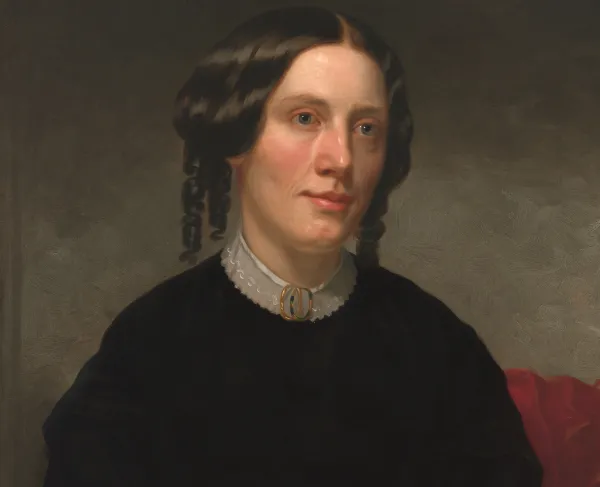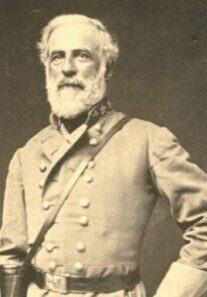Harriett Beecher Stowe
June 14, 1811 - July 1, 1896
Abolitionist and Author
Abolitionist and Author
From Litchfield, Connecticut
Served in Hartford, Connecticut
Affiliation:
"Religion! Is what you hear at church religion? Is that which can bend and turn, and descend and ascend, to fit every crooked phase of selfish, worldly society, religion? Is that religion which is less scrupulous, less generous, less just, less considerate for man, than even my own ungodly, worldly, blinded nature? No! When I look for religion, I must look for something above me, and not something beneath."
Harriet Beecher Stowe remains one of the most recognizable names in United States history. Her seminal work, Uncle Tom’s Cabin, is often credited as a catalyst for the Civil War and stands as a monumental contribution to abolitionist literature. However, Stowe’s convictions transcended political discourse, delving into profound moral and spiritual realms. While her historical legacy often centers on this singular novel, Stowe’s life and work encompassed far more. Born into a prominent family and emerging as a leader in antebellum society, her influence extended well beyond the pages of her most famous book.
Born on June 14, 1811, in Litchfield, Connecticut, Harriet Beecher was the daughter of Lyman Beecher, a renowned Presbyterian minister and co-founder of the American Temperance Society. Her upbringing in the intellectually vibrant and spiritually charged Beecher household profoundly shaped her worldview. Educated at the Hartford Female Seminary, founded by her sister Catharine, Harriet received classical training in literature, rhetoric, and theology, which was an uncommon opportunity for women of her time.
This rigorous education honed Stowe’s skills in writing and oratory, equipping her to engage with pressing social issues. More importantly, it instilled in her a vision of faith as an active force against injustice. Her beliefs deepened during her time at Lane Seminary in Cincinnati, where her father served as president. There, she became immersed in the fervent abolitionist movement, interacting with prominent figures like Theodore Weld and her future husband, Calvin Stowe. The seminary’s ideological split, leading to the formation of Oberlin College, further solidified her commitment to the anti-slavery cause.
In the quiet of her parlor, Harriet Beecher Stowe experienced a vision that would haunt her thoughts and stir her conscience. She saw a dying slave, frail and emaciated, his dark skin stretched taut over his bones, his eyes sunken but alight with a strange, serene resignation. His breath came in shallow gasps, each one a faint whisper of suffering and stolen life. Around him, white masters went about their business, indifferent to his agony, while other enslaved people looked on—some weeping quietly, others staring in mute despair. Yet in this moment, Stowe saw more than just suffering. A soft, radiant light seemed to surround the dying man, as though a divine presence stood beside him, acknowledging a truth the world ignored. Here lay a man crushed beneath the weight of human cruelty, yet sanctified by his suffering. Stowe did not see just a victim; she saw a martyr, a soul whose quiet endurance spoke louder than any cry for mercy. This vision stayed with her, not merely as an image but as a revelation. It became the soul of Uncle Tom’s Cabin, a story that would reach across oceans and shake the conscience of a nation.
This vision, along with the enactment of the Fugitive Slave Act of 1850, compelled her to write Uncle Tom’s Cabin. Initially serialized in The National Era, an abolitionist newspaper, the novel reached a vast audience, with its emotional narrative bringing the horrors of slavery to the forefront of Northern consciousness.
The novel’s impact was immediate and profound. Upon its publication in 1852, it sold over 300,000 copies in the United States within a year and more than a million copies in Great Britain. Its vivid storytelling transformed the abstract moral question of slavery into a deeply personal and national crisis. Stowe’s portrayal of the Fugitive Slave Law highlighted the complicity of the North in the institution of slavery, challenging readers to confront their own moral responsibilities.
Stowe’s faith was inseparable from her work. While she did not align herself with a specific denomination, her Christianity was deeply activist. She lectured, wrote, and corresponded with fellow reformers, consistently framing abolition as a moral imperative. In response to critics who questioned the authenticity of her novel, Stowe published A Key to Uncle Tom’s Cabin in 1853, providing documentation and firsthand accounts to substantiate her narrative. This work underscored her commitment to truth and her reliance on primary sources, including narratives from formerly enslaved individuals like Josiah Henson.
Stowe’s influence extended beyond literature. In 1853, she traveled to Great Britain, where she was received with great enthusiasm. During her visit, she was presented with the Stafford House Address, a petition signed by over half a million British women urging their American counterparts to work towards the abolition of slavery. This international recognition highlighted the global impact of her work and the transatlantic solidarity in the fight against slavery.
Although Uncle Tom’s Cabin remains her most renowned work, Stowe authored over 30 books, encompassing novels, essays, and articles that addressed various social issues, including women’s rights and domestic life. Her collaboration with her sister Catharine on The American Woman’s Home in 1869 aimed to educate women on domestic science, reflecting her belief in the importance of women’s roles in shaping moral and ethical households.
Harriet Beecher Stowe’s writing was not simply a matter of literary talent; it was an expression of her deep Christian faith, a faith rooted in the conviction that moral truth must lead to action. Raised in a family where religion and reform were inseparable, Stowe saw Christianity as a call to confront injustice, to be a force for good in a fallen world. For her, the teachings of Christ were not abstract ideals but a living mandate to love one’s neighbor, defend the oppressed, and speak for those without a voice. This conviction found its fullest expression in Uncle Tom’s Cabin, a novel that drew from the well of her spiritual beliefs and her outrage at the suffering of the enslaved. In its pages, Stowe’s faith became a catalyst for change. She portrayed the horrors of slavery as a profound sin against God and humanity. Her characters were not just figures in a story but living embodiments of Christian virtue and suffering, designed to touch hearts and awaken souls. Through her pen, Stowe transformed faith into action, creating a work that stirred the conscience of a nation.
Harriet Beecher Stowe’s life and work exemplify the power of literature as a tool for social change. Her unwavering commitment to justice, rooted in deep moral and spiritual convictions, left an indelible mark on American society. Stowe’s enduring influence serves as a testament to the profound impact that one individual’s conscience and pen can have on the course of history.




